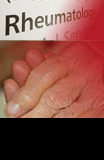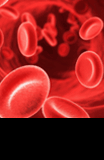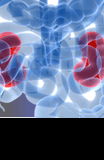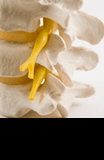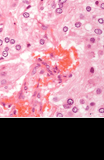Background information
Familial hypercholesterolemia (FH) is predominantly an autosomal dominant disorder, characterised by increased plasma levels of total cholesterol and low-density lipoprotein cholesterol.
Other clinical features which can be associated with FH include the following.
- Tendon xanthoma - clinically characterised by papules and nodules found in the tendons of the hands, feet, and heels.
- Corneal arcus - a white or grey arc at the outer margin of the cornea if found in an individual less than 45 years old.
- Xanthelasma - a sharply demarcated yellowish deposit of cholesterol underneath the skin, which usually occurs on or around the eyelids.
- Increased carotid artery intima-media thickness has been associated with young patients with FH.
Heterozygous FH occurs in one in 200-250 in the Caucasian population with the homozygous form affecting 1/1,000,000. Homozygotes have a more severe phenotype; their plasma LDL is increased up to five-fold (20-25mmol/l) and fatal coronary artery disease occurs in the early stages of life.
The following genes and loci have been associated with raised cholesterol:
LDLR: Pathogenic variants in the LDLR gene are the most common cause of FH. Pathogenic variants cause autosomal dominant hypercholesterolaemia, and rarely homozygous and compound heterozygous variants have been described in cases of severe hypercholesterolaemia. Copy number variants have been identified.
APOB: Pathogenic variants cause autosomal dominant hypercholesterolaemia. Pathogenic variants of the APOB gene account for ~5% of autosomal FH cases. The disorder resulting from pathogenic variants in this gene has been termed 'familial defective apolipoprotein B-100' (FDB).
APOE: Pathogenic variants in APOE are an infrequent cause (~1%) of autosomal dominant hypercholesterolaemia. Homozygous pathogenic variants may result in a concomitant and proportional increase in triglycerides and be associated with familial dysbetalipoproteinemia type III.
PCSK9: Pathogenic variants cause autosomal dominant hypercholesterolaemia. Pathogenic variants in PCSK9 account for a much smaller percentage of FH cases than pathogenic variants in LDLR and APOB. However the c.1120G>T p.(Asp374Tyr) pathogenic variant is thought to account for ~2% of patients with FH and may be the single most common FH variant in the UK.
LDLRAP1: Pathogenic variants cause autosomal recessive hypercholesterolaemia. Patients with homozygous or compound heterozygous pathogenic variants in LDLRAP1 have clinical features similar to those with homozygous pathogenic variants in LDLR with severely elevated plasma low density lipoprotein (LDL) cholesterol, tendon xanthomata and premature atherosclerosis.
Multiple: Genome wide association studies (GWAS) have identified several loci that are associated with small additional raised cholesterol risks. Genotype analysis of 12 SNPs provides a measure of risk for significantly raised cholesterol and is described as a polygenic risk score (PRS) [1].
Dutch (or Welsh) lipid clinic score >5, or Simon Broome criteria indicate possible FH (following assessment in a specialist lipid clinic or Familial Hypercholesterolaemia Service).
Referrals for testing will be triaged by the Genomic Laboratory; testing should be targeted at those where a genetic or genomic diagnosis will guide management for the proband or family.
Testing strategy
Clinically affected probands:
R134.1 - analysis for small variants in the gene panel indicated below (includes analysis of polygenic risk score SNPs) †
R134.2 - MLPA for exon level copy number variants in LDLR gene
† Note the SNPs genotyped in this assay, the corresponding weighted SNP score, and polygenic risk score deciles have been validated in individuals of northern European ancestry. These scores may not accurately reflect the likelihood of hypercholesterolaemia being polygenic in origin in other populations[1]
Genes tested:
Genes analysed are in accordance with the 'green' high evidence of clinical association gene list in panel app:
LDLR, APOB, APOE, PCSK9 and LDLRAP1
Targeted analysis for known / previously reported familial variants:
- Presymptomatic testing in clinically unaffected family members at risk of inheriting a previously reported familial pathogenic variant (R242)
- Diagnostic confirmation in individuals at risk of inheriting a previously reported familial pathogenic variant and clinically suspected of having the familial condition (R240)
- Segregation studies in affected family members to aid variant interpretation (R375)
- Prenatal diagnosis (although not typically requested)
- Carrier testing in relatives of clinically affected patients with an autosomal recessive condition (variant(s) known) (R244)
Target reporting times
- 42 calendar days for diagnostic screening of affected individuals
- 42 calendar days for diagnostic confirmation in individuals at risk of inheriting a previously reported familial pathogenic variant and clinically suspected of having the familial condition (R240)
- 14 calendar days for presymptomatic testing of clinically unaffected family members at risk of inheriting a previously reported familial pathogenic variant (R242)
- 14 calendar days for Carrier testing in relatives of clinically affected patients with an autosomal recessive condition (variant(s) known) (R244).
Sample requirements and referral information
All non NHSE referrals should be accompanied by a completed referral form.
Clinical guidance and advice is available to referring consultants from:
Professor Fredrik Karpe, Professor of Medicine
OCDEM, Churchill Hospital
Email: fredrik.karpe@ocdem.ox.ac.uk
Requesting specialties:
- Cardiology
- Chemical Pathology
- Clinical Genetics
- Metabolic Medicine
- Paediatrics (with the involvement of a lipid specialist)
Contact us
Email: fhservice.oxfordgenetics@ouh.nhs.uk
Anthony O'Rourke
John Taylor
Kate Thomson
Price list for non NHSE referrals (pdf)
References
[1] Talmud et al 2013, Use of low-density lipoprotein cholesterol gene score to distinguish patients with polygenic and monogenic familial hypercholesterolaemia: a case-control study; Lancet 2013, April 13, 381(9874):1293-1301, PMID: 23433573.














